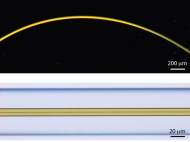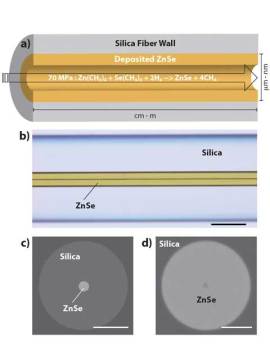Zinc Selenide optical fibers capable to transfer infrared light
 A team of researchers at Penn State University (PSU) has developed the very first optical fiber made with a core of Zinc Selenide (ZnSe) – a light-yellow compound that can be used as a semiconductor. The new class of optical fiber, which allows for a more effective and liberal manipulation of light, promises to open the door to more versatile laser-radar technology.
A team of researchers at Penn State University (PSU) has developed the very first optical fiber made with a core of Zinc Selenide (ZnSe) – a light-yellow compound that can be used as a semiconductor. The new class of optical fiber, which allows for a more effective and liberal manipulation of light, promises to open the door to more versatile laser-radar technology.
“Glass has a haphazard arrangement of atoms”, said lead researcher John Badding, professor at PSU Department of Chemistry. “In contrast, a crystalline substance like Zinc Selenide is highly ordered. That order allows light to be transported over longer wavelengths, specifically those in the mid-infrared.”
Unlike silica glass, which traditionally is used in optical fibers, ZnSe is a compound semiconductor. By using an innovative high-pressure chemical-deposition technique developed by Justin Sparks, a graduate student in the Department of Chemistry, Badding and his team deposited ZnSe waveguiding cores inside of silica glass capillaries to form the new class of optical fibers.
The researchers found that the optical fibers made of zinc selenide could be useful in two ways. First, they observed that the new fibers were more efficient at converting light from one color to another. Second, as Badding and his team expected, they found that the new class of fiber provided more versatility not just in the visible spectrum, but also in the infrared (optical-fiber technology was inefficient at transmitting infrared light).
“Exploiting these wavelengths is exciting because it represents a step toward making fibers that can serve as infrared lasers”, Badding added. “For example, the military currently uses laser-radar technology that can handle the near-infrared, or 2 to 2.5-micron range. A device capable of handling the mid-infrared, or over 5-micron range would be more accurate. The fibers we created can transmit wavelengths of up to 15 microns.”
This technology could lead to advances in fiber-based guiding, imaging, spectroscopy and tunable lasers which could be applied to improve surgical and medical lasers, or develop better countermeasure lasers used by the military, and superior environment-sensing lasers such as those used to measure pollutants and to detect the dissemination of bioterrorist chemical agents.
For more information, you can read their article published in the Advanced Materials journal named: “Zinc Selenide Optical Fibers”.










Leave your response!